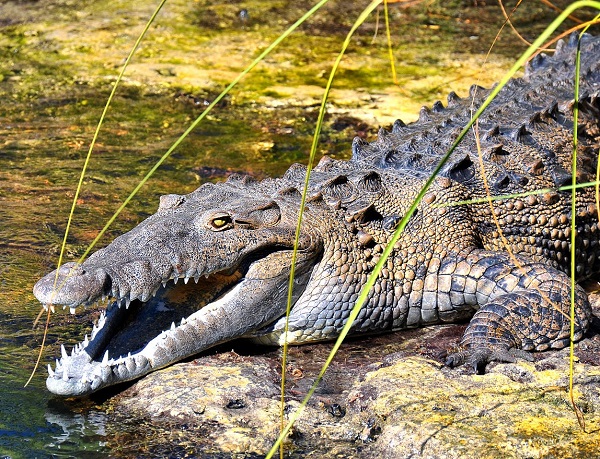Top 10 Most Dangerous Wild Animals of America
There are many different kinds of wild creatures in America’s enormous and varied wilderness, some of which may be harmful to people because of their size, strength, venom, or aggressive nature. The top ten most deadly wild animals in America are examined in depth below:
1. Grizzly Bear (Ursus arctos horribilis)
One of the most dangerous creatures in North America is the grizzly bear, which is recognized for its enormous size, powerful strength, and unpredictable behavior. These apex predators, which are mostly found in Alaska and the western United States, may weigh up to 1,500 pounds and have strong jaws and keen claws that can cause serious injury. Even though they are uncommon, grizzly bear assaults on people can happen when the bears feel irritated or threatened, particularly in situations where there is rivalry for food or surprise.
2. American Alligator (Alligator mississippiensis)
Large reptiles with strong jaws and a cunning hunting style, American alligators are native to the southeast region of the country. Alligators have been known to attack people, even though their usual prey is fish, birds, and small mammals. This usually happens when the animals feel threatened or when people get too closely to their natural habitat. Attacks by alligators can be lethal, and their victims frequently sustain serious wounds from their bites and flailing.
3. Mountain Lion (Puma concolor)
Mountain lions are sly predators that may be found throughout the western United States. They are also referred to as cougars or pumas. While attacks on people are uncommon, mountain lions have been known to ambush hikers, runners, or bikers who are unprepared, particularly in isolated wilderness regions. Being solitary creatures, mountain lions usually stay away from human conflict, but interactions can turn deadly if the cats sense danger or believe that people are their potential food.
4. Eastern Diamondback Rattlesnake (Crotalus adamanteus)
The eastern diamondback rattlesnake, the largest venomous snake in North America, is found in the southeast of the country. These snakes, with their long fangs and strong venom, are very dangerous to people if they accidentally agitate or disturb them. If left untreated, bites from eastern diamondback rattlesnakes can result in serious tissue damage, agony, and sometimes even death. When exploring their environment, take the necessary measures to avoid encounters with these snakes.
5. Black Widow Spider (Latrodectus mactans)
Black widow spiders are common in North America and are well-known for their strong venom and eye-catching crimson hourglass markings. Black widow spiders seldom kill their victims, but when they do, their neurotoxic venom can leave victims with acute agony, cramping in the muscles, and other systemic symptoms. Black widow spider encounters tend to take place in shady, dark places like garages, sheds, or woodpiles. Because of the potential severity of their bites, black widow spiders should be handled carefully even though they are little in size.
6. Brown Recluse Spider (Loxosceles reclusa)
Brown recluse spiders are frequently found in the southern and central regions of the United States. They are well-known for their poisonous bites, which can leave people with necrotic sores and other catastrophic health consequences. Being nocturnal, brown recluse spiders usually live in isolated, dark areas like crawl spaces, attics, and closets. Although these spiders are not very common, when they bite, the harm they cause can be permanent, necessitating immediate medical attention to avoid problems.
7. American Bison (Bison bison)
Despite being well-known as emblems of the American West, American bison may be extremely dangerous to people, particularly if they are approached or provoked. Although they have a gentle demeanor, bison are strong animals who can run up to 35 miles per hour. Human-bison attacks frequently happen when people approach the animals too closely, try to pet them, or take pictures with them. Serious injuries from bison collisions might include internal damage and fractured bones.
8. Coyote (Canis latrans)
Opportunistic predators, coyotes are found all over North America, particularly in urban and suburban environments. They can feed on small mammals, birds, and even household pets. Although they rarely attack people, coyotes can turn hostile when they perceive humans as a potential food source or if they feel in danger. It is best to approach coyote encounters cautiously and take precautions to reduce the likelihood of conflict, such as securing trash and leash pets.
9. Eastern Timber Rattlesnake (Crotalus horridus)
Another deadly snake species that threatens people is the eastern timber rattlesnake, which is found in the eastern United States. Potential predators are advised to avoid the timber rattlesnake due to its distinct rattle and mysterious coloring. Human contact is still possible, though, particularly in areas that are known to be forested or rocky where these snakes live. Timber rattlesnake bites can result in excruciating pain, edema, and tissue damage; therefore, it’s important to get medical assistance right once to avoid problems.
10. American Crocodile (Crocodylus acutus)
The American crocodile, a massive reptile native to southern Florida, can be dangerous to people, particularly in places where human activity conflicts with crocodile habitats. Although they rarely attack people, American crocodiles are strong predators with a strong bite. It is best to avoid coming into contact with crocodiles and to take the necessary safety measures when working or recreation in regions where these reptiles are known to be present.
Summary
In conclusion, a wide variety of wildlife may be found in America, some of which may be dangerous to people in specific situations. Even though interactions with hazardous wild animals are uncommon, it’s important for people to treat wildlife in their natural environment and when exploring wilderness regions with caution and respect. Through education about the habits and environments of potentially harmful animals and the use of proper safety measures, people may reduce the likelihood of conflict and safely coexist with the amazing wildlife of America’s great outdoors.

